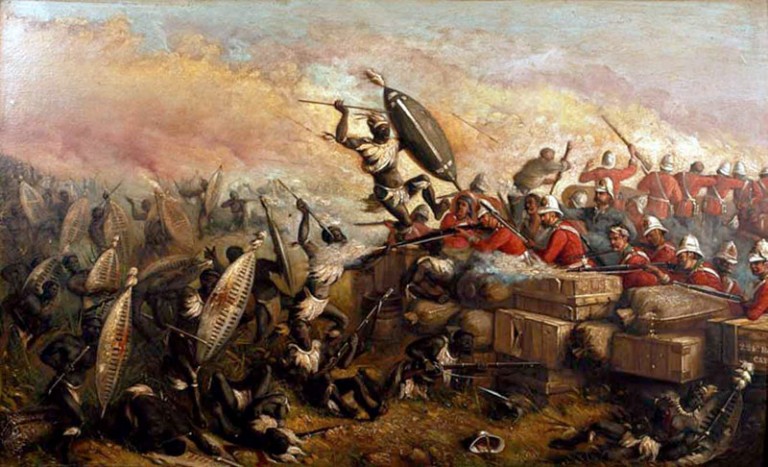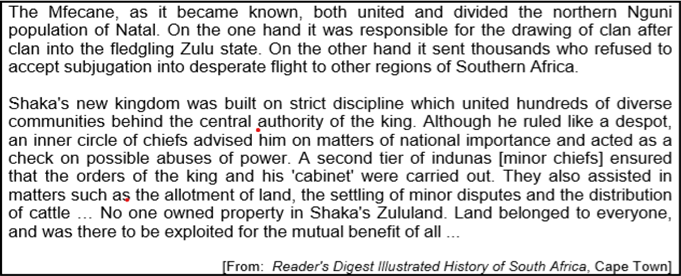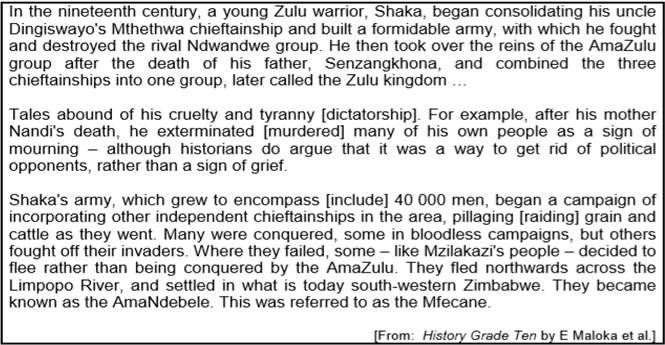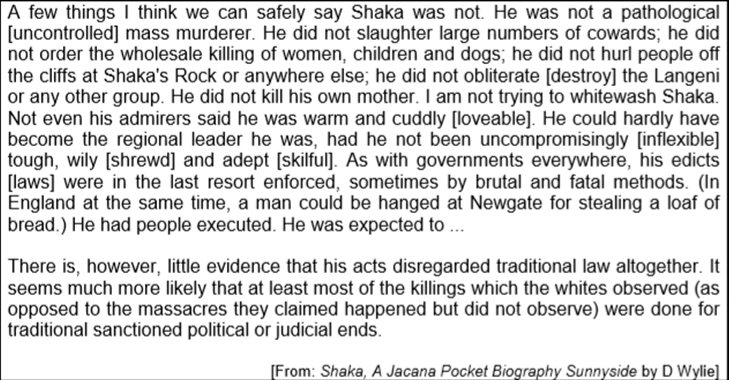Transformations in southern Africa after 1750
Source Based Questions
The following exercise has been taken from the 2012 History Grade 10 Exemplar. [1]
 “The Mfecane 1816 – 28”, History Notes, (Uploaded: 5 April 2016), (Accessed: 5 August 2020) Image Source
“The Mfecane 1816 – 28”, History Notes, (Uploaded: 5 April 2016), (Accessed: 5 August 2020) Image Source
Source A
 See footnote for origin of the source[2]
See footnote for origin of the source[2]
Define the term “Mfecane” in the context of the start of the nineteenth century. (1 x 2)
The Zulu term “Mfecane” is translated as “crushing” in English, however the term is broadened to include the dispersal or forced migration of people.[3] Historians use the term Mfecane to describe the political disruption and mass migration of people during the start of the nineteenth century in Southern Africa. [4]
According to Source A, what impact did the Mfecane have on the Northern Nguni population in Natal? (1 x 2)
According to Source A the Mfecane caused division as well as the unification of the Northern Nguni population. Those who accepted Shaka Zulu’s rule were integrated into his kingdom and became united and strong. However, not everyone wanted to be subjects of Shaka Zulu and attempting to maintain their autonomy they fled to other parts of Southern Africa.
According to Source A, how did Shaka Zulu maintain control over his kingdom? (1x3)
Shaka Zulu was the main ruler of his kingdom, however he did have a group of advisors who could give him insight on matters of national importance. Shaka also made sure that his orders were followed and maintained control over his kingdom by using a “second tier of indunas” otherwise known as “minor chiefs” to ensure that his commands were adhered to. Shaka gave these chiefs power to allot the land that were community property of the entire kingdom.
Source B
This source focuses on one of the reasons for the Mfecane (Difaqane). It gives a traditional view of King Shaka as the leader of the Zulus.
 See footnote for origin of the source[2]
See footnote for origin of the source[2]
2.1. Using source B, describe the impact of Shaka Zulu’s Mfecane. (2x4)
Source B describes the violence and bloodshed of Shaka Zulu’s reign alongside the forced migration that occurred due to Shaka’s goal to enlarge and enrich his kingdom. Shaka destroyed tribes, such as the Ndwandwe group and incorporated them in his own army and the AmaZulu group he became leader of after the death of his father. He continued to pillage the lands and cattle of other independent chieftainships till he conquered them and subjected them to his rule. By doing this Shaka united many chieftainships under his rule, which empowered and enriched his Zulu nation. However, Shaka’s Mfecane threatened the existence of various chieftainships and while others willingly became incorporated into his group, others fought to the death or fled, becoming victims of a forced migration to Southern Africa.
2.2. Why does this source describe Shaka Zulu as a cruel tyrant? (1x2)
After his mother’s death Shaka executed many of his people. This is believed to have been done to mourn her death, however it is unclear whether there was a political reason for their execution.
Source C
 See footnote for origin of the source[6]
See footnote for origin of the source[6]
3.1. Compare Source B and C. How is Shaka portrayed in these two sources? (2x4)
In Source B Shaka is described as a cruel tyrant who possibly executed his own people to mourn the death of his mother. While they are uncertain about whether this is completely accurate, they do still indicate that if this was the case he did kill a lot of people for no reason. He is also described as focused on enriching and empowering himself and his kingdom at the cost of other African groups lives while those who survived were either dispersed or forced to become a loyal subject to Shaka Zulu.
In Source C the author states that he does not view Shaka as this “pathological mass murderer” that is clearly sketched in Source B. While the source does indicate that Shaka was a strong ruler, who did were shrewd and skillful, the author argues that Shaka had justifiable political and judicial reasons for killing people.
Ultimately, both sources show uncertainty about Shaka’s reasons for killing his people. Source B leans more towards Shaka being a cruel tyrant, while Source C argues that this is most likely not the case. Rather Shaka was a wise ruler who sentenced people to death for political reasons.
Source D
He is Shaka the Unshakeable,
Thunderer-while-sitting,
Son of Menzi,
He is the bird that preys on other birds,
The battle-axe that excels over other battle-axes.
He is the long-strided pursuer,
son of Ndaba,
Who pursued the sun and the moon.
He is the great hubbub like the rocks of Nkandla
Where elephants take shelter
When the heavens frown...
(translated by Ezekiel Mphahlale)
See footnote for origin of the source[7]
4. 1 How is Shaka Zulu remembered in this praise song? (2x3)
Shaka Zulu is remembered as a very strong warrior, since he is the “bird that preys on other birds”[8] and the “battle-axe that excels over other battle-axes”.[9] He is also remembered as an ambitious leader, since the lyrics state that he “pursued the sun and the moon”.[10] Lastly, Shaka’s kingdom and leadership is remembered as steadfast and secure, since he is viewed as the “great hubbub like the rocks of Nkandla”[11], which reinforces the first line of the lyrics that states that he is “Shaka the Unshakeable.” [12]
This content was originally produced for the SAHO classroom by
Ilse Brookes, Amber Fox-Martin & Simone van der Colff
End Notes
[1] The Western Cape Education Department, South Africa, “History Grade 10 2012 Exemplar,” Accessed 20 September 2020, Available at: http://www.wcedcurriculum.westerncape.gov.za/jdownloads/History/Downloads/history_gr_10_exemplar_2012_eng.pdf
[2] The Department of Basic Education South Africa, “National Senior Certificate: Grade 10 History Exemplar 2012 Addendum”, (Uploaded: November 2012), (Accessed: 5 August 2020), Available at: https://learn.mindset.africa/sites/default/files/resourcelib/emshare-exam-resource/History%20GR%2010%20Exemplar%202012%20Addendum%20Eng.pdf
[3] Alistair Boddy-Evans, “The Mfecane in South Africa”, ThoughtCo, (Uploaded: 1 September 2018), (Accessed: 5 August 2020), Available at: https://www.thoughtco.com/what-was-the-mfecane-43374
[4] Ibid.
[5] The Department of Basic Education South Africa, “National Senior Certificate: Grade 10 History Exemplar 2012 Addendum”, (Uploaded: November 2012), (Accessed: 5 August 2020), Available at: https://learn.mindset.africa/sites/default/files/resourcelib/emshare-exam-resource/History%20GR%2010%20Exemplar%202012%20Addendum%20Eng.pdf
[6]The Department of Basic Education South Africa, “National Senior Certificate: Grade 10 History Exemplar 2012 Addendum”, (Uploaded: November 2012), (Accessed: 5 August 2020), Available at: https://learn.mindset.africa/sites/default/files/resourcelib/emshare-exam-resource/History%20GR%2010%20Exemplar%202012%20Addendum%20Eng.pdf
[7]Editors of Encyclopaedia Britannica, “Praise Song”, Encyclopaedia Britannica, (Uploaded: 20 July 1998), (Accessed: 5 August 2020), Available at: https://www.britannica.com/art/praise-song
[8] Ibid.
[9] Ibid.
[10] Ibid.
[11] Ibid.
[12] Ibid.